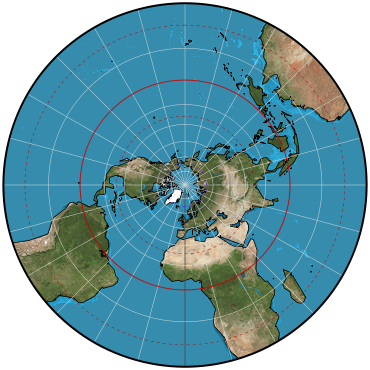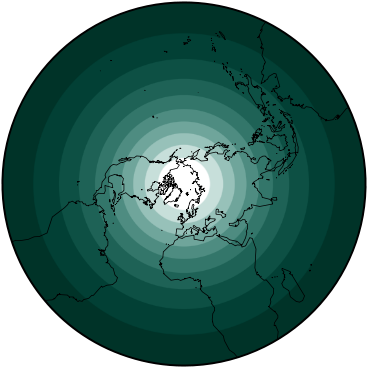Classifications
azimuthal
polyconic
conformal
perspective
Graticule
Polar aspect:.
Meridians: Equally spaced straight lines intersecting at central pole. Angles between them are the true angles.
Parallels: Unequally spaced circles centered at the pole, which is a point. Opposite pole cannot be shown. Spacing gradually increases away from the pole.
Symmetry: About any meridian.
Equatorial aspect:.
Meridians: Central meridian is a straight line. Other meridians are unequally spaced circular arcs intersecting at each pole. Spacing gradually increases away from the central meridian.
Parallels: Equator is a straight line. Other parallels are unequally spaced circular arcs concave toward the nearest pole. Spacing gradually increases away from the equator along the central meridian, but spacing is equal along the meridians 90° from the central meridian.
Symmetry: About the central meridian or the equator.
Oblique aspect:.
Meridians: Central meridian is a straight line. Other meridians are circular arcs intersecting at each pole and having their centers on the straight parallel opposite in sign to the central latitude. Spacing gradually increases away from the central meridian.
Parallels: The parallel opposite in sign to the central latitude is a straight line perpendicular to the central meridian. All other parallels are circular arcs concave toward the pole on the same side of the straight parallel.
Symmetry: About the central meridian.
Range
One hemisphere conveniently; most but not all of the other hemisphere at accelerating scale.
Scale
True only where the central latitude crosses the central meridian or, alternatively, along a circle concentric about the projection center (or a parallel on the polar aspect). Scale is constant along any circle having its center at the projection center, but scale increases moderately with distance from the center within a hemisphere.
Distortion
Only the center or the circle of true scale (if not the center) is free from all distortion.
Special features
All great or small circles (including all meridians and parallels) on the globe are shown as circular arcs or straight lines. Perspective projection of the globe onto a tangent (or secant) plane from a point on the surface just opposite the point of tangency or the projection center. The straight parallel of latitude passes through this point.
Usage Commonly used in the polar aspect for topographic maps of polar regions. The equatorial aspect was used regularly for maps of the Eastern and Western Hemispheres in the 17th and 18th centuries. Oblique aspects are used to show paths of solar eclipses.
Recommended for conformal mapping of regions approximately circular in shape.
Basis of modified Stereographic conformal projections using complex algebra, such as the Miller Oblated Stereographic.
Origin
Apparently developed in polar aspect by Egyptians and Greeks by the 2d century B.C.
Description adapted from J.P. Snyder and P.M. Voxland, An Album of Map Projections, U.S. Geological Survey Professional Paper 1453. United States Government Printing Office: 1989.
 Cylindric
Cylindric Pseudocylindric
Pseudocylindric Conic
Conic Azimuthal
Azimuthal Lenticular
Lenticular Miscellaneous
Miscellaneous

